从中西方情人节看中西方的文化差异
- 格式:pdf
- 大小:1.69 MB
- 文档页数:2

中国与外国七夕节区别跨文化对比训练中国与外国七夕节区别跨文化对比训练中国和外国的七夕节虽然都是传统的情人节,但是由于文化背景和习俗的不同,两者在庆祝方式、节日内涵以及活动特色上存在着明显的区别。
本文将从这三个方面进行跨文化对比,分析中国与外国七夕节的异同。
一、庆祝方式在中国,七夕节被称为“中国情人节”,主要的庆祝方式是男女间的浪漫交流。
传统的习俗是以佳人织女和牛郎相会为主题,许多人会喜欢在这一天赠送礼物或者举办浪漫的约会。
而在外国,尤其是西方国家,情人节通常是一个更为宽泛的概念,并没有严格的日期限制。
许多国家将情人节定在2月14日,这一天的庆祝方式更为多样化,除了浪漫相会外,也包括互赠贺卡、送花和赏月等等。
二、节日内涵七夕节在中国有着悠久的历史渊源和浪漫的传说,在文化上具有独特的内涵。
传说中,七夕是牛郎织女天河鹊桥相会的日子,因此被视为中国的情人节。
人们常常用这个节日表达爱意和美好的祝福,加深感情。
而在外国,情人节并没有太多的历史和传说故事,更多的是商业推波助澜。
外国人通常将这一天视为表达爱意和情感的好机会,通过送礼物、赠送花束或者举行浪漫的晚餐来表达爱意。
三、活动特色七夕节是中国传统节日中的浪漫佳节,人们在这一天经常会赏月、挂灯笼、放烟花、写信贴在树上等等。
此外,七夕节还有一个重要的习俗是女孩们在这天乞巧,既可以练习手艺,还可以表达爱意。
而在外国,在情人节这天,人们通常会送对方一些特别的礼物,例如巧克力、鲜花或者珠宝等。
很多地方会举办特别的活动,如音乐会、烛光晚餐或者夜间浪漫游览等,营造浪漫的氛围。
综上所述,中国与外国的七夕节在庆祝方式、节日内涵以及活动特色上存在较大的差异。
中外文化在情人节的传统习俗和庆祝方式上有着明显的差异,这也反映了两个国家在情感表达方式和价值观念上的差异。
不同的节日风俗,既丰富了人们的生活,又展示了不同文化的魅力。
我们应该在尊重和理解他人的同时,欣赏和推崇各自的文化传统,促进跨文化交流与对比的学习,增进友谊与互信。
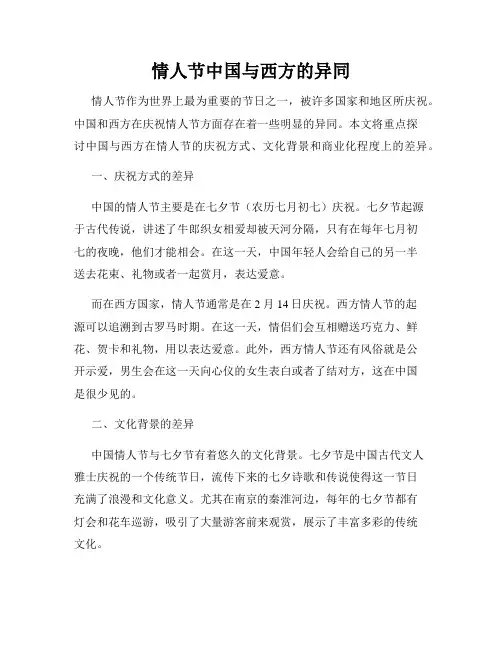
情人节中国与西方的异同情人节作为世界上最为重要的节日之一,被许多国家和地区所庆祝。
中国和西方在庆祝情人节方面存在着一些明显的异同。
本文将重点探讨中国与西方在情人节的庆祝方式、文化背景和商业化程度上的差异。
一、庆祝方式的差异中国的情人节主要是在七夕节(农历七月初七)庆祝。
七夕节起源于古代传说,讲述了牛郎织女相爱却被天河分隔,只有在每年七月初七的夜晚,他们才能相会。
在这一天,中国年轻人会给自己的另一半送去花束、礼物或者一起赏月,表达爱意。
而在西方国家,情人节通常是在2月14日庆祝。
西方情人节的起源可以追溯到古罗马时期。
在这一天,情侣们会互相赠送巧克力、鲜花、贺卡和礼物,用以表达爱意。
此外,西方情人节还有风俗就是公开示爱,男生会在这一天向心仪的女生表白或者了结对方,这在中国是很少见的。
二、文化背景的差异中国情人节与七夕节有着悠久的文化背景。
七夕节是中国古代文人雅士庆祝的一个传统节日,流传下来的七夕诗歌和传说使得这一节日充满了浪漫和文化意义。
尤其在南京的秦淮河边,每年的七夕节都有灯会和花车巡游,吸引了大量游客前来观赏,展示了丰富多彩的传统文化。
相比之下,西方情人节缺乏这种深厚的文化背景。
尽管情人节起源于古罗马时期的基督教传统,但随着时间的推移,它已经演变成商业化的节日。
现代的西方情人节更多地侧重于商业宣传和消费,人们更多地注重赠送昂贵的礼物和参加浪漫的晚餐。
因此,尽管有浪漫的氛围,但西方情人节的文化意义相对较低。
三、商业化程度的差异中国和西方在情人节的商业化程度上存在明显的差异。
在中国,七夕节的商业化程度相对较低。
尽管现代商业将七夕节与产品推销结合在一起,但这一节日的商业宣传相对较少。
七夕节更多地被人们视为一种浪漫的象征,更加强调情侣之间的关系和感情。
与此相反,西方情人节的商业化程度极高。
商家们利用这个时机推销各种礼品、巧克力、红酒、鲜花等产品。
商场和网店也推出各种打折优惠活动,吸引消费者购买。
因此,西方情人节被认为是一个商机,商家们纷纷推出促销活动,推动经济发展。
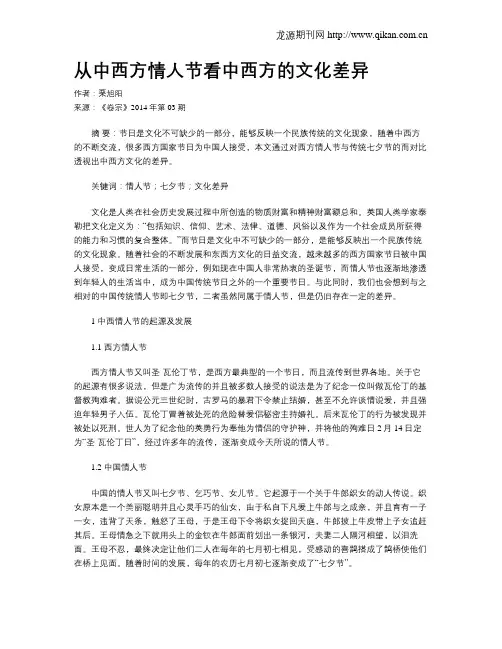
从中西方情人节看中西方的文化差异作者:栗旭阳来源:《卷宗》2014年第03期摘要:节日是文化不可缺少的一部分,能够反映一个民族传统的文化现象,随着中西方的不断交流,很多西方国家节日为中国人接受,本文通过对西方情人节与传统七夕节的而对比透视出中西方文化的差异。
关键词:情人节;七夕节;文化差异文化是人类在社会历史发展过程中所创造的物质财富和精神财富额总和。
英国人类学家泰勒把文化定义为:“包括知识、信仰、艺术、法律、道德、风俗以及作为一个社会成员所获得的能力和习惯的复合整体。
”而节日是文化中不可缺少的一部分,是能够反映出一个民族传统的文化现象。
随着社会的不断发展和东西方文化的日益交流,越来越多的西方国家节日被中国人接受,变成日常生活的一部分,例如现在中国人非常热衷的圣诞节,而情人节也逐渐地渗透到年轻人的生活当中,成为中国传统节日之外的一个重要节日。
与此同时,我们也会想到与之相对的中国传统情人节即七夕节,二者虽然同属于情人节,但是仍旧存在一定的差异。
1 中西情人节的起源及发展1.1 西方情人节西方情人节又叫圣·瓦伦丁节,是西方最典型的一个节日,而且流传到世界各地。
关于它的起源有很多说法,但是广为流传的并且被多数人接受的说法是为了纪念一位叫做瓦伦丁的基督教殉难者。
据说公元三世纪时,古罗马的暴君下令禁止结婚,甚至不允许谈情说爱,并且强迫年轻男子入伍。
瓦伦丁冒着被处死的危险替爱侣秘密主持婚礼。
后来瓦伦丁的行为被发现并被处以死刑。
世人为了纪念他的英勇行为奉他为情侣的守护神,并将他的殉难日2月14日定为“圣·瓦伦丁日”,经过许多年的流传,逐渐变成今天所说的情人节。
1.2 中国情人节中国的情人节又叫七夕节、乞巧节、女儿节。
它起源于一个关于牛郎织女的动人传说。
织女原本是一个美丽聪明并且心灵手巧的仙女,由于私自下凡爱上牛郎与之成亲,并且育有一子一女,违背了天条,触怒了王母,于是王母下令将织女捉回天庭,牛郎披上牛皮带上子女追赶其后。
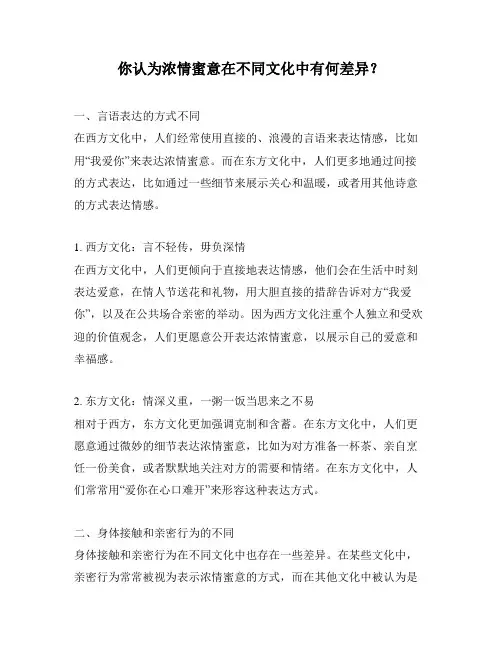
你认为浓情蜜意在不同文化中有何差异?一、言语表达的方式不同在西方文化中,人们经常使用直接的、浪漫的言语来表达情感,比如用“我爱你”来表达浓情蜜意。
而在东方文化中,人们更多地通过间接的方式表达,比如通过一些细节来展示关心和温暖,或者用其他诗意的方式表达情感。
1. 西方文化:言不轻传,毋负深情在西方文化中,人们更倾向于直接地表达情感,他们会在生活中时刻表达爱意,在情人节送花和礼物,用大胆直接的措辞告诉对方“我爱你”,以及在公共场合亲密的举动。
因为西方文化注重个人独立和受欢迎的价值观念,人们更愿意公开表达浓情蜜意,以展示自己的爱意和幸福感。
2. 东方文化:情深义重,一粥一饭当思来之不易相对于西方,东方文化更加强调克制和含蓄。
在东方文化中,人们更愿意通过微妙的细节表达浓情蜜意,比如为对方准备一杯茶、亲自烹饪一份美食,或者默默地关注对方的需要和情绪。
在东方文化中,人们常常用“爱你在心口难开”来形容这种表达方式。
二、身体接触和亲密行为的不同身体接触和亲密行为在不同文化中也存在一些差异。
在某些文化中,亲密行为常常被视为表示浓情蜜意的方式,而在其他文化中被认为是不适宜的。
1. 北美文化:拥抱与亲吻在北美文化中,拥抱和亲吻是常见的表示浓情蜜意的方式。
夫妻之间、恋人之间、朋友之间,甚至是陌生人之间,在适当的场合下,这种身体接触被认为是一种表达关爱和温暖的方式。
2. 亚洲文化:传统与现代的差异相比之下,亚洲文化中,特别是传统文化中,人们对身体接触和亲密行为持更加保守的态度。
尽管如今在某些亚洲城市中,年轻一代的观念发生了变化,但在不少地方,身体接触和亲密行为仍被视为私密和保守的事情。
三、节日和庆祝活动的差异不同文化中的节日和庆祝活动也是表达浓情蜜意的重要渠道。
不同的传统和文化习俗使得全球各地的庆祝方式截然不同。
1. 情人节:西方的浓情之夜在西方文化中,情人节是表达浓情蜜意的重要时刻。
人们会通过赠送鲜花、巧克力、贺卡等方式来向心爱的人表达热爱和浓情蜜意。
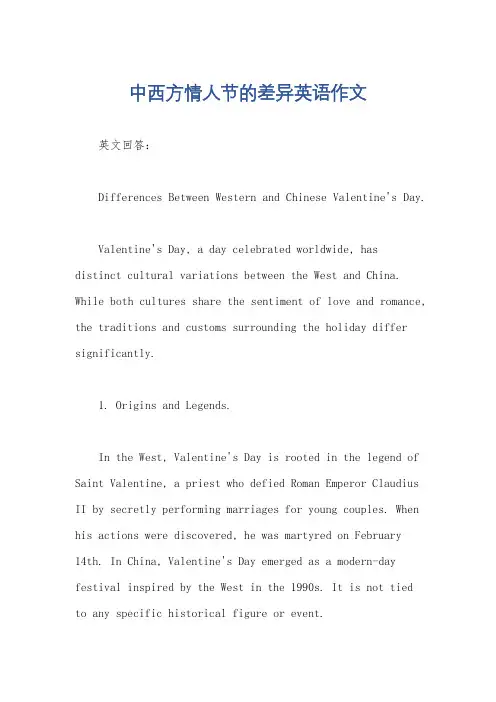
中西方情人节的差异英语作文英文回答:Differences Between Western and Chinese Valentine's Day.Valentine's Day, a day celebrated worldwide, hasdistinct cultural variations between the West and China. While both cultures share the sentiment of love and romance, the traditions and customs surrounding the holiday differ significantly.1. Origins and Legends.In the West, Valentine's Day is rooted in the legend of Saint Valentine, a priest who defied Roman Emperor Claudius II by secretly performing marriages for young couples. When his actions were discovered, he was martyred on February14th. In China, Valentine's Day emerged as a modern-day festival inspired by the West in the 1990s. It is not tiedto any specific historical figure or event.2. Date.Valentine's Day is celebrated on February 14th in the West. However, in China, it is celebrated on August 20th, coinciding with the Chinese Qixi Festival. Qixi originated from a folk tale about a cowherd and a weaver girl who could only meet once a year on the seventh day of the seventh lunar month (which typically falls in August).3. Gender Roles.In the West, Valentine's Day is traditionally a day when men express their love and affection to women. They typically send flowers, chocolates, and gifts. In China, gender roles are more balanced. Both men and women give and receive gifts on Valentine's Day.4. Gift-Giving.In the West, popular Valentine's Day gifts include flowers, chocolates, jewelry, and heartfelt cardsexpressing romantic sentiments. In China, gifts are often more practical and tangible, such as clothing, electronics, or home appliances.5. Commercialization.Valentine's Day has become a highly commercialized holiday in the West. Businesses capitalize on the occasion by selling a wide range of romantic merchandise. In China, while the holiday has also gained commercial popularity, it is not as pervasive as in the West.6. Romantic Gestures.In the West, Valentine's Day is a day for grand gestures of love, such as candlelit dinners, serenades, and marriage proposals. In China, romantic expressions tend to be more subtle and indirect. Couples may go on dates, exchange small gifts, or share romantic messages oversocial media.7. Societal Significance.Valentine's Day holds a different level of societal significance in the West and China. In the West, it is considered a major romantic holiday, celebrated with great enthusiasm. In China, it is more of a secular occasion, not as deeply ingrained in the cultural fabric.8. Cultural Impact.Valentine's Day has had a significant cultural impact in both the West and China. It has influenced music, literature, film, and art. In particular, it has popularized the idea of romantic love and the pursuit of a significant other.中文回答:西方情人节与中国情人节的差异。
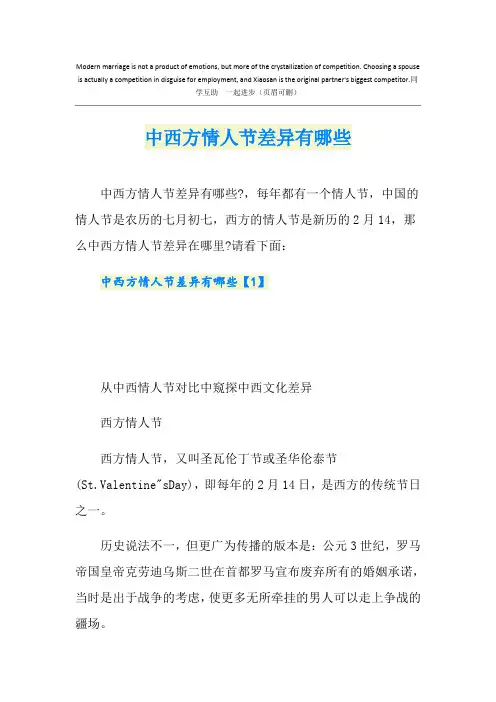
Modern marriage is not a product of emotions, but more of the crystallization of competition. Choosing a spouse is actually a competition in disguise for employment, and Xiaosan is the original partner's biggest competitor.同学互助一起进步(页眉可删)中西方情人节差异有哪些中西方情人节差异有哪些?,每年都有一个情人节,中国的情人节是农历的七月初七,西方的情人节是新历的2月14,那么中西方情人节差异在哪里?请看下面:中西方情人节差异有哪些【1】从中西情人节对比中窥探中西文化差异西方情人节西方情人节,又叫圣瓦伦丁节或圣华伦泰节(St.Valentine"sDay),即每年的2月14日,是西方的传统节日之一。
历史说法不一,但更广为传播的版本是:公元3世纪,罗马帝国皇帝克劳迪乌斯二世在首都罗马宣布废弃所有的婚姻承诺,当时是出于战争的考虑,使更多无所牵挂的男人可以走上争战的疆场。
一名叫瓦仑廷(SanctusValentinus)的神父没有遵照这个旨意而继续为相爱的年轻人举行教堂婚礼。
事情被告发后,瓦仑廷神父先是被鞭打,然后被石头掷打,最后在公元270年2月14日这天被送上了绞架被绞死。
14世纪以后,人们就开始纪念这个日子。
现在,中文译为“情人节”的这个日子,在西方国家里就被称为Valentines Day,用以纪念那位为情人做主而牺牲的神父。
中国情人节中国情人节,是人们俗称的七夕节,也有人称之为“乞巧节”或“女儿节”,这是中国传统节日中最具浪漫色彩的一个节日,也是过去姑娘们最为重视的日子。
相传地上的`牛郎和天上的仙女相恋,被被天庭的玉帝和王母娘娘知道后,他们勃然大怒,并命令天神下界抓回织女。
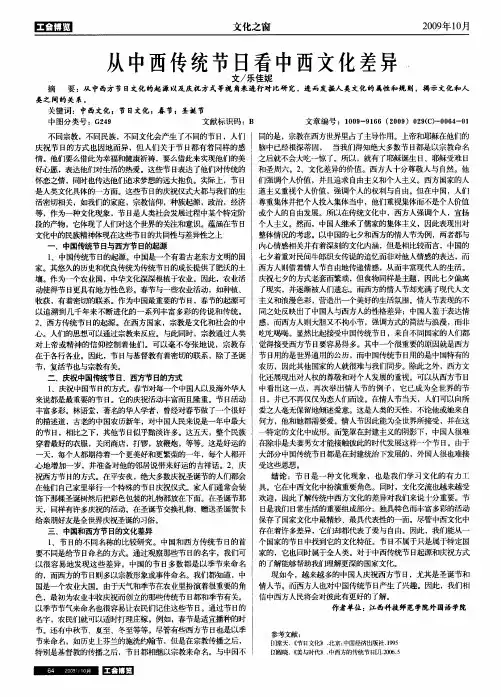
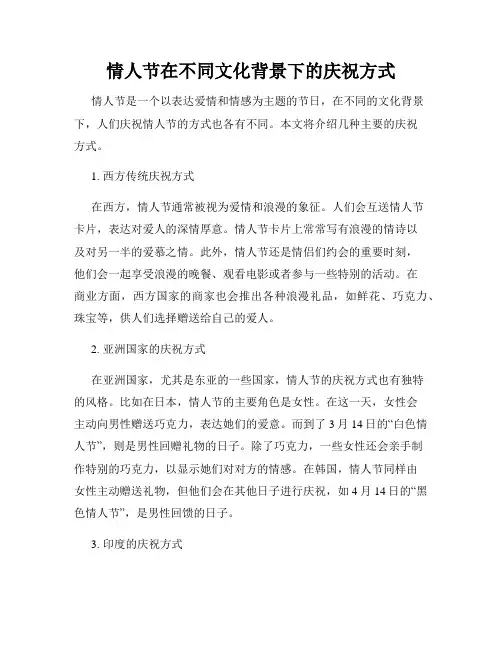
情人节在不同文化背景下的庆祝方式情人节是一个以表达爱情和情感为主题的节日,在不同的文化背景下,人们庆祝情人节的方式也各有不同。
本文将介绍几种主要的庆祝方式。
1. 西方传统庆祝方式在西方,情人节通常被视为爱情和浪漫的象征。
人们会互送情人节卡片,表达对爱人的深情厚意。
情人节卡片上常常写有浪漫的情诗以及对另一半的爱慕之情。
此外,情人节还是情侣们约会的重要时刻,他们会一起享受浪漫的晚餐、观看电影或者参与一些特别的活动。
在商业方面,西方国家的商家也会推出各种浪漫礼品,如鲜花、巧克力、珠宝等,供人们选择赠送给自己的爱人。
2. 亚洲国家的庆祝方式在亚洲国家,尤其是东亚的一些国家,情人节的庆祝方式也有独特的风格。
比如在日本,情人节的主要角色是女性。
在这一天,女性会主动向男性赠送巧克力,表达她们的爱意。
而到了3月14日的“白色情人节”,则是男性回赠礼物的日子。
除了巧克力,一些女性还会亲手制作特别的巧克力,以显示她们对对方的情感。
在韩国,情人节同样由女性主动赠送礼物,但他们会在其他日子进行庆祝,如4月14日的“黑色情人节”,是男性回馈的日子。
3. 印度的庆祝方式在印度,情人节通常被称为“费布鲁瑟七日”。
这一庆祝活动从2月7日开始,持续至2月14日,每一天都有特定的主题。
比如2月7日是“玫瑰日”,情侣们会互赠玫瑰花;2月9日是“巧克力日”,他们会互送巧克力;2月12日是“拥抱日”,情侣们会拥抱彼此表达爱意。
整个庆祝过程非常浪漫,逐渐激发了印度年轻人对情人节的热情。
4. 非洲的庆祝方式在非洲一些国家,情人节被视为一个重要的社交活动。
人们会举办各种聚会、音乐会和舞会来庆祝这一节日。
他们会穿着传统服装,跳起传统舞蹈,在音乐的伴奏下度过一个愉快的夜晚。
此外,一些非洲国家还会组织一些慈善活动,以表达对弱势群体的爱和关怀。
总之,情人节庆祝方式的多样性反映了不同文化背景下的爱情观和价值观的差异。
无论是西方的浪漫礼物,亚洲的巧克力回赠,印度的费布鲁瑟七日,还是非洲的社交聚会,每一种方式都代表了人们对爱情的热爱和追求。
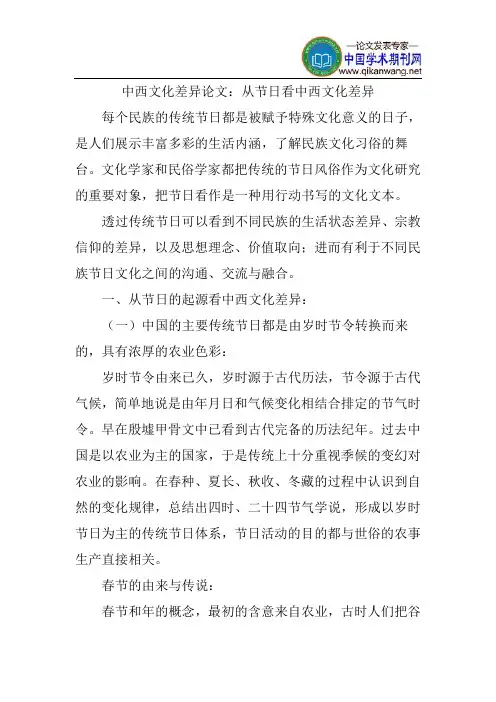
中西文化差异论文:从节日看中西文化差异每个民族的传统节日都是被赋予特殊文化意义的日子,是人们展示丰富多彩的生活内涵,了解民族文化习俗的舞台。
文化学家和民俗学家都把传统的节日风俗作为文化研究的重要对象,把节日看作是一种用行动书写的文化文本。
透过传统节日可以看到不同民族的生活状态差异、宗教信仰的差异,以及思想理念、价值取向;进而有利于不同民族节日文化之间的沟通、交流与融合。
一、从节日的起源看中西文化差异:(一)中国的主要传统节日都是由岁时节令转换而来的,具有浓厚的农业色彩:岁时节令由来已久,岁时源于古代历法,节令源于古代气候,简单地说是由年月日和气候变化相结合排定的节气时令。
早在殷墟甲骨文中已看到古代完备的历法纪年。
过去中国是以农业为主的国家,于是传统上十分重视季候的变幻对农业的影响。
在春种、夏长、秋收、冬藏的过程中认识到自然的变化规律,总结出四时、二十四节气学说,形成以岁时节日为主的传统节日体系,节日活动的目的都与世俗的农事生产直接相关。
春节的由来与传说:春节和年的概念,最初的含意来自农业,古时人们把谷的生长周期称为“年”,《说文禾部》:“年,谷熟也。
”在夏商时代产生了夏历,以月亮圆缺的周期为月,一年划分为十二个月,每月以不见月亮的那天为朔,正月朔日的子时称为岁首,即一年的开始,也叫年。
农历正月初一通常都在立春前后,因而把农历正月初一定为“春节”,俗称阴历年。
(二)西方的传统节日的起源都带有浓厚的宗教色彩:与中国的相比西方的传统节日的起源都带有浓厚的宗教色彩。
自从欧洲大陆被基督教文明浸染后,西方几乎所有影响最大的传统节日都与基督教有关,而且随着基督教跨文明的普世化和欧洲移民向世界各大洲的播散,成为了世界性的节日。
圣诞节的由来:圣诞节是基督教世界最大的节日。
圣诞节是基督徒纪念耶稣诞生的一个重要节日。
根据圣经记载耶稣诞生在犹太的一座小城——伯利恒。
该书记载圣母玛利亚是因圣神的感动而怀孕,就在与丈夫若瑟返往家乡时遇上所有的旅店客满,因此玛利亚被迫在马槽里产下耶稣。
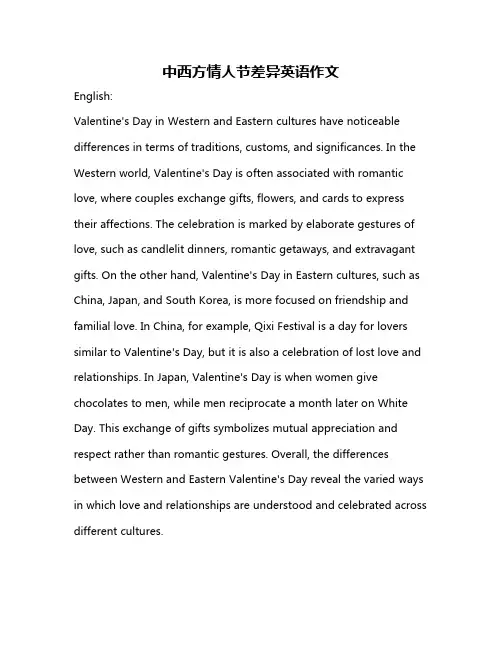
中西方情人节差异英语作文English:Valentine's Day in Western and Eastern cultures have noticeable differences in terms of traditions, customs, and significances. In the Western world, Valentine's Day is often associated with romantic love, where couples exchange gifts, flowers, and cards to express their affections. The celebration is marked by elaborate gestures of love, such as candlelit dinners, romantic getaways, and extravagant gifts. On the other hand, Valentine's Day in Eastern cultures, such as China, Japan, and South Korea, is more focused on friendship and familial love. In China, for example, Qixi Festival is a day for lovers similar to Valentine's Day, but it is also a celebration of lost love and relationships. In Japan, Valentine's Day is when women give chocolates to men, while men reciprocate a month later on White Day. This exchange of gifts symbolizes mutual appreciation and respect rather than romantic gestures. Overall, the differences between Western and Eastern Valentine's Day reveal the varied ways in which love and relationships are understood and celebrated across different cultures.中文翻译:西方和东方文化中的情人节在传统、习俗和意义上有明显的差异。
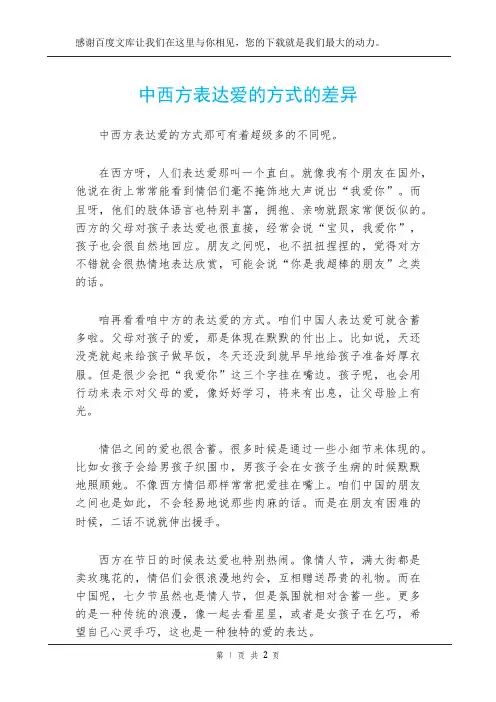
中西方表达爱的方式的差异中西方表达爱的方式那可有着超级多的不同呢。
在西方呀,人们表达爱那叫一个直白。
就像我有个朋友在国外,他说在街上常常能看到情侣们毫不掩饰地大声说出“我爱你”。
而且呀,他们的肢体语言也特别丰富,拥抱、亲吻就跟家常便饭似的。
西方的父母对孩子表达爱也很直接,经常会说“宝贝,我爱你”,孩子也会很自然地回应。
朋友之间呢,也不扭扭捏捏的,觉得对方不错就会很热情地表达欣赏,可能会说“你是我超棒的朋友”之类的话。
咱再看看咱中方的表达爱的方式。
咱们中国人表达爱可就含蓄多啦。
父母对孩子的爱,那是体现在默默的付出上。
比如说,天还没亮就起来给孩子做早饭,冬天还没到就早早地给孩子准备好厚衣服。
但是很少会把“我爱你”这三个字挂在嘴边。
孩子呢,也会用行动来表示对父母的爱,像好好学习,将来有出息,让父母脸上有光。
情侣之间的爱也很含蓄。
很多时候是通过一些小细节来体现的。
比如女孩子会给男孩子织围巾,男孩子会在女孩子生病的时候默默地照顾她。
不像西方情侣那样常常把爱挂在嘴上。
咱们中国的朋友之间也是如此,不会轻易地说那些肉麻的话。
而是在朋友有困难的时候,二话不说就伸出援手。
西方在节日的时候表达爱也特别热闹。
像情人节,满大街都是卖玫瑰花的,情侣们会很浪漫地约会,互相赠送昂贵的礼物。
而在中国呢,七夕节虽然也是情人节,但是氛围就相对含蓄一些。
更多的是一种传统的浪漫,像一起去看星星,或者是女孩子在乞巧,希望自己心灵手巧,这也是一种独特的爱的表达。
还有啊,西方的家庭聚会,大家会很热情地互相拥抱亲吻,表达思念和爱。
在中国的家庭聚会里,大家更多的是围坐在一起,吃着热乎乎的饭菜,那种亲情的爱就在饭菜的香气和欢声笑语里。
这种爱是默默的,但是却很深厚。
中西方表达爱的方式虽然有这么多的差异,但无论是直白还是含蓄,都是爱呀。
就像不同口味的美食,各有各的美妙之处。
西方的直白表达让爱像阳光一样热烈,咱们中国的含蓄表达则让爱像涓涓细流,慢慢地滋润心田。
中西方情人节异同英语作文English: In both Eastern and Western cultures, Valentine's Day is a day dedicated to celebrating romantic love. However, there are some key differences between how the two cultures observe this special day. In the Western world, Valentine's Day is widely celebrated on February 14th with the exchange of gifts, flowers, chocolates, and cards expressing love and affection. It is common for couples to go out for a romantic dinner or spend quality time together. On the other hand, in Eastern cultures like China, Valentine's Day is not as widely celebrated and traditional festivals such as Qixi Festival (Chinese Valentine's Day) hold more importance. Qixi Festival falls on the seventh day of the seventh month in the lunar calendar and typically involves wishes for love, happiness, and good fortune. Furthermore, in Western culture, Valentine's Day is often associated with grand gestures of love and romance, while in Eastern culture, love is often expressed through subtlety and understated actions. Despite these differences, the essence of Valentine's Day remains the same in both cultures - a day to express love and appreciation for those closest to us.中文翻译: 在东西方文化中,情人节都是一个专注于庆祝浪漫爱情的日子。
七夕节与西方的情人节的异同七夕节和西方的情人节,作为两个重要的情人节,有着各自的独特风格和传统。
七夕节是中国传统的情人节,而西方的情人节则是源于古罗马的传统节日。
虽然两个节日都庆祝爱情和浪漫,但它们之间有着不同的起源和习俗。
本文将从起源、习俗和文化意义三个方面来探讨七夕节与西方的情人节的异同。
起源方面,七夕节和西方的情人节有着截然不同的背景故事。
七夕节,也被称为中国情人节,起源于中国古代的传说故事,其中牛郎织女的故事最为著名。
这个故事讲述了牛郎和织女由于离别而每年只能在七夕这一天相会的传说。
西方的情人节则源自于古罗马的节日,称为“瓦伦丁节”,以纪念一个叫瓦伦丁的圣人。
根据传说,瓦伦丁是一个与情侣们秘密结婚的牧师,后来因为违抗皇帝的命令而被处决,而他的死日即成为情人节。
习俗方面,七夕节和西方的情人节在庆祝方式和传统习俗上也存在差异。
七夕节的庆祝活动通常包括送花、赏月、写信和祈福等,最为著名的习俗是女孩子们在这一天织七夕绣,祈求巧安能织成良缘。
西方的情人节则以互赠礼物、写情书、赠送巧克力、约会和表白等浪漫行为为主要特点。
在西方国家,情人节往往是一天里男性向女性表达爱意和赠送礼物的时间。
而在中国,七夕节则更强调女性对男性的表示和表达。
文化意义方面,七夕节和西方的情人节在文化内涵和价值观上也体现出明显的差异。
七夕节在中国文化中强调婚姻、爱情和幸福的理念。
它被认为是一个浪漫的节日,代表了爱情和相聚的意义。
而西方的情人节则更加注重表达爱意和感恩之情。
对于西方社会来说,情人节代表了浪漫和爱情的概念,也成为商业化程度极高的节日之一。
综上所述,七夕节和西方的情人节虽然都是庆祝爱情和浪漫的节日,但它们在起源、习俗和文化意义上存在明显的差异。
七夕节强调中国传统文化和古代传说,突出了婚姻和幸福的意义;而西方的情人节源于古罗马,更加注重表达爱意和感恩之情。
两个节日都承载着人们对爱情的向往和追求,不同的风俗和传统也反映了不同国家和文化的特色与习俗。
中西方节日文化差异比较传统的民族节日形成是一个民族的历史文化的长期积淀。
节日的由来原因与人们的生活有密切的联系, 它体现了人民丰富的情感世界, 寄托了人民对生活的热爱。
有这样一句名言: “每个民族的每个节日, 正是反映这个民族文化最真实的一面”。
可见, 要了解一个民族的文化底蕴, 必须从他们的传统节日入手, 才能了解到他们的文化特色与民族特点。
一、中西节日的起源与形成差异中国长期以来处于封建自给自足的农业社会和自然经济中, 其传统节日具有浓厚的农业色彩,包含了农耕文明的社会特征, 主要是从岁时节令转换而来的。
我国古代长期以农为本, 在生产力和农业技术不发达的情况下, 十分重视气候对农作物的影响。
在春种、夏长、秋收、冬藏的过程中认识了自然时序的复杂规律, 总结出四时、二十四节气, 形成了以节日为主的传统节日。
勤劳的中国人民为了更好地生存, 必须大力发展农业, 而农业的发展离不开天气的关照。
古人云“春雨贵如油”、“清明忙种麦, 谷雨种大田”。
在古代, 春节、清明节( 古代称三月节) 等都是重要的农事节日。
西方文化由于长久受基督教的影响, 其传统节日起源带有浓厚的宗教色彩, 如情人节( 纪念名叫瓦丁的基督教殉难者) 、复活节( 基督教纪念耶稣复活) 、万圣节( 纪念教会所有圣人) 、圣诞节( 基督教纪念耶稣诞生) , 这些节日的起源大多与宗教有关系。
当然, 西方节日中也有和农业有关的节日, 但他们以农业为主的节日的历史不如中国漫长。
二、中西节日庆祝方式差异中国的传统节日, 基本是封建社会时期形成的, 不可避免地留下封建社会的痕迹: 等级制、家族式, 节日无不以家族内部活动为中心。
西方的传统节日就不同了, 更多的是表现出人们的互动性、集体性和狂欢性, 以自我为中心, 崇尚个性张扬。
这与中国节日的家族性恰好相反, 体现了西方文化的群体性, 反映了人们渴望互相交流、群体参与的愿望,体现了人人平等、自由表现自我的特点。
An Analysis of Cultural Differences between Chinese and Western Valentine’s Day摘要随着中国对外交流和合作的不断深化与加强,很多源于西方的节日受到越来越多的中国人的追捧和喜欢。
与此同时,一些中国的传统节日也受到外国人喜爱。
本文将以七夕节和情人节为例,对比其相同点和不同点,并得出结论。
对于相同点,作为最具浪漫色彩的节日,在节日期间人们会互赠礼物,举行各种各样的庆祝活动。
对于不同点,情人节的起源与基督教有关;而七夕节则起源于牛郎与织女的故事,更具有民间性和神话性。
本文通过对中、西方情人节的比较,了解两个情人节的相同和不同之处。
通过相关探讨,让更多的人了解本民族节日文化的内涵,让国人认识到他们的相似之处,更让他们看到二者的差异和不同。
只有这样才有利于中国传统节日和文化的弘扬与光大。
关键词:七夕节;情人节;异同点;比较研究ContentsIntroduction (1)Chapter One Literature Review (3)1.1 Domestic Studies (3)1.2 Foreign Studies (5)Chapter Two Differences of Origins and Customs (7)2.1 Different Origins (7)2.1.1 Origins of Qixi Festival (7)2.1.2 Origins of Western Valentine’s Day (8)2.1.3 Comparison of Origins (8)2.2 Different Customs (9)2.2.1 Customs of Qixi Festival (9)2.2.2 Customs of Valentine’s Day (10)2.2.3 Comparison of Customs (8)Chapter Three Differences of Cultural Backgrounds and Religious Concepts (12)3.1 Different Cultural Backgrounds (12)3.1.1 Cultural Background of Qixi Festival (12)3.1.2 Cultural Background of Valentine’s Day (13)3.1.3 Comparison of Backgrounds (8)3.2 Differences in Religious Attitudes (14)3.2.1 Religious Attitude towards Qixi Festival (14)3.2.2 Religious Attitudes towards Valentine’s Day (14)3.2.3 Comparison of Religious Attitudes (8)Chapter Four Conclusion (16)References (117)IntroductionFor many years, Qixi Festival and Valentine’s Day have always been compared, so the differences and the relationship between them are worth studying.The connotation of each festival is profound, and different festivals also contain a different culture. These cultures are truly reflected in people's lives. With the exchanges and cooperation between different countries, the cultural and daily exchanges between different countries are deepening day by day, and the development of world culture also shows diversity. The convergence of cultures brings rich connotations to the culture of the world. Western festival culture has been widely spread into China, Chinese traditional festivals and western festival cultures have been collided. As a traditional festival in China, Qixi Festival is a significant festival for ancient women, also known as the “Qiqiao Festival”. The folk custom of this day is also extended and developed with women’s skillful begging as the core, and accompanied by the tradition of begging for love. After Valentine’s Day, was popularized in China, Qixi Festival was gradually crowned with the title of “Chinese Valentine’s Day” with westernization effect. Although Qixi Festival and Valentine’s Day do not have any historical origins, they are also very popular in China today. There are differences and characteristics between the two festivals.Since the beginning of the 21st century, this has gone global. With the close exchanges between Chinese and foreigners, many western festivals have been spread to China (newspapers, news, videos and other channels). These festivals bring fresh feelings to the Chinese people and are gradually loved by the Chinese people. More and more Chinese people are celebrating Western festivals. They send gifts, sing songs and travel to celebrate Western festivals. As the most representative Valentine's Day in the West, it is popular among young people in China. Many young people will follow the example of Westerners to celebrate this festival. At the same time, Chinese traditional festivals have been impacted in this context. It is quite right that Qixi Festival has not received the attention it deserves. Many young people don't know much about the connotation of traditional Chinese festivals, let alone celebrate them. For this question, we need to think deeply: what is the reasonfor this situation? The answer is that many Chinese people lack a comprehensive and dialectical understanding of Chinese and Western festivals. Therefore, it is necessary to compare the two, so that Chinese people can recognize their similarities and differences. Only in this way can we promote the promotion and development of Chinese traditional festivals and culture.This thesis chooses Valentine’s Day and Qixi Festival as typical cases to study the spread of Chinese and Western festival culture, and attempts to study the differences between the two. By studying the current situation of Valentine’s Day and Qixi Festival in China, this thesis explores the cultural differences behind the festivals and their impacts. How to develop and promote the two festivals to carry forward the cultural connotation of our traditional festivals is also very important.Chapter One Literature ReviewThis research is based on the theme of scholars’ research on Valentine’s Day in China and the West in the context of globalization, focusing on consulting scholars’ research results, differences and comparative studies of Chinese and Western festivals on Valentine’s Day, including Western Valentine’s Day and China’s Qixi Day.From the early 1980s to the 1990s, research on the Qixi Festival gradually increased, but mainly focused on history, literature and art, anthropology, folklore and sociology. Most of the studies are the introduction of Qixi folk customs and the literary study of Qixi poems and songs. It was first published by Zhang Jun in “Exploring the Origin of Qixi Festival”. Luo Jing (2022: 44-48) pointed out that the Qixi Festival originated in the Warring States Period. By sorting out the evolution of the legend of Niulang and Zhīnǚ, the author creatively argues that the traditional female-centred celebrations contain the values that the ancient society expected from women. In the 21st century, with the development of the market economy and the growing prosperity of business, research on the Qixi Festival has also changed. The first report to publicly call Qixi Festival “China Valentine’s Day” was published in the Factory Manager’s Daily in September 2001 under the title of Calling China’s Qixi Brand.The article pointed out that Western Valentine’s Day had entered the Chinese market in a comprehensive way. If you want to get a share of the Qixi Festival, you have to build Qixi into a cultural brand with commercial value (Wang, 2016: 25-29). So far, many scholars have started to study from the perspective of economics. For example, in the article “Symbolic Economy and the Qixi Festival as an Intangible Cultural Heritage”, the author Jia Xiaofeng took the symbolic value of the Qixi Festival as an example to talk about how culture can be transformed into resources. In addition, the academic community began to have new thoughts about the survival status of the Qixi Festival. For example, the author of “Survival through Reconstruction —— Thoughts on the Fate of the Qixi Festival”, by analyzing the reasons for the plight of the Qixi Festival, suggested thatthe reconstruction of the Qiqiao Festival into a husband and wife festival might be a possibility for its survival (Yang, 2019: 12-16). Since 2005, academic research on the Qixi Festival has seen a tremendous growth. Many scholars have begun to think about Qixi Festival and “China Valentine’s Day” in different ways, and to reflect on and criticize the simple positioning of Qixi Festival as “China Valentine’s Day”. The modern transformation of Qixi Festival is mainly due to its untimely connotation of begging and the development of love connotation; another example is that people believe that there is a big difference between Qixi Festival in China and Valentine’s Day in the West. In order to save Qixi Festival, we should not blindly imitate Valentine’s Day. It is worth noting that since the beginning of this period, more and more researchers have begun to study the introduction of the Qixi Festival from the perspective of communication studies. For example, Ye Shuxian (2015: 23-28) points out in his article From Qixi to Chinese Valentine’s Day: The Reconstruction of Traditional Festival Culture by the Mass Media that the excavation, The packaging and repackaging of traditional culture by the mass media has become a new trend, and the author believes that the Qixi Festival is not the focus of the media, but only a necessary or dispensable background. In this reporting mode, the audience unconsciously accepted that Qixi is China’s Valentine’s Day, which ultimately led to the real reconstruction of Qixi culture and folklore.Using the Qixi Festival in two places in Zhejiang Province as a case study, it is suggested that the so-called “traditional” festivals have already gone through a series of cultural evolutionary processes of stability, variation, error, intertextuality and reconstruction, and that local traditions in the Chinese context have also evolved into modern traditions in the context of globalization (Li, 2018: 75-77). In Zhang Yonghui’s (2020: 111-115) Master of Folklore thesis, Festivals of Love: Probing into the Sequence of Contemporary Love Festivals in China, Through the horizontal comparison between Qixi Festival and Singles’ Day, the author shows many differences between Chinese people at different times in terms of love festivals.The author also conducts a field survey on the survival status of the contemporary Qixi Festival, which has certain reference significance for the study of this paper.1.2 Foreign StudiesThe The focus of foreign research on Western Valentine’s Day has changed over time. The 1989 paper “Saint Valentine’s Day in the United States” is the earliest available research on Valentine’s Day in the West. The title indicates that the author used the literal name of the holiday rather than calling it “Valentine’s Day”. After 1993, Valentine’s Day became popular in society (Bochow, 2017: 195-218). Research on Valentine’s Day mainly comes from English-language professional journals and magazines, which mainly introduce the history, customs and significance of Valentine’s Day in the West. At the beginning of the 21st century, economics and consumerism have become new perspectives of Valentine’s Day research. At this stage, the interaction between festivals and social economy, festivals and consumer culture have become the focus of research (James, 2015: 72-73). After 2005, the academic community began to re-examine and reflect on the impact of the spread of Western festivals on traditional Chinese folk festivals. Globalization has brought Western Valentine’s Day, while traditional Chinese festivals have been “shelled out”. Around 2010, more and more studies focused on the localisation characteristics of Western Valentine’s Day and its impact on the Qixi Festival. Western festivals in China, where there is no Christian soil, are more like rootless trees, carnival, open and playful emotional colors of capitalist social culture. Valentine’s Day is more popular than Qixi, and this paper explores the influence of Western Valentine’s Day on Chinese society through linguistic expressions of love and romantic consumption. Larry (2020: 21-23) in Folklore Thinking on the Development and Transformation of Foreign Festivals in Shanghai, from the perspective of folklore, examines the background and development of the spread of Western festivals including Valentine’s Day in Shanghai, and analyzes the causes and social effects of the “foreign festival fever”.In Valentine’s Day in Kumasi, Ghana: diversity and changes in international relations, Yusuf (2012: 372-375) noted that in Japan, Western Valentine’s Day as a widely accepted consumer ritual is the result of multicultural integration. He also explored the reasons for the widespread celebration of Valentine’s Day among young people in Ghana. The researchers found that this phenomenon is closely linked to the emergence of communication technology. Media and technology have changed intergenerational relationships and sexual attitudes in Ghanaian society, while spreading Valentine's Day culture.Stuart (2018: 78-80), in the second chapterof his book Representation, Cultural Representation and Signature Practice, made a study entitled “Love in the Age of Valentine and Pink Underwear: Media and the Politics of Intimacy in South Asia”. The author argues that images and media play a crucial role in the cross-cultural communication of love on Valentine’s Day, which has become a ceremony of self-display and self-creation for young couples in India. In celebrating “love”, this festival also emphasizes the fun of dating and eating. Consumption and public displays of emotion are “happiness”. In this festival, couples have established open and legal romantic feelings. The author explores Valentine’s Day and romantic love among urban youth in India, as well as the temporal and spatial boundaries between the private and public spheres in the celebration of the festival.1.3 SummaryLooking at the research of scholars at home and abroad on Valentine’s Day in China and the West, we can find a rule that scholars first introduced the two festivals, then described the phenomenon, and finally conducted critical research on Valentine’s Day On the whole, the academic research on Valentine’s Day in China and the West has shown the characteristics of the times.Compared with the research of Western scholars, the research of Chinese scholars on Qixi Day and Valentine’s Day mostly focuses on the superficial presentation of cultural phenomena and festival communication, and lacks a comprehensive discussion of the deep impact of Western cultural implantation from the perspective of media, culture, sociology, etc., and also lacks a comparison of the origin, customs, and connotation of the two.Chapter Two Differences of Origins and CustomsInfluenced by different regions and cultures, different festivals have different customs. In this section, the author will take the Qixi Festival and the Valentine’s Day Festival as examples and explore the differences in their origins and customs. 2.1 Different OriginsTo understand a festival, we must first understand its origin. This section will analyse the origin and background of the Qixi Festival and Valentine’s Day.2.1.1 Origins of the Qixi FestivalChina’s Qixi Festival has its origins in the love story between a cowherd and a weaver in the Han Dynasty. With the help of the cowherd, who fed the old cow, they fell in love, got married and had a son and a daughter. But all this was against the law of heaven. The Queen Mother herself forced the weaver girl to return to heaven. The cowherd put on shoes made from the hide of a dead old cow and took a pair of children with him to catch up. When she was about to catch up, the Queen Mother pulled off the golden hairpin on her head and waved it, and a Tianhe River appeared. The Cowherd and the Weaver Girl were forced to separate, and Weaver Girl could only keep crying. Their faithful love moved Magpie, so thousands of magpies flew to build a bridge for them. In this way, the Cowherd and the Weaver Girl can meet on the bridge. The Empress had no choice but to allow them to meet on the Thousand Magpies’ Bridge every year on the 7th of July. The day they met was called the “Qixi Festival”.The Qixi Festival is also known as the Qiqiao Festival. Qiqiao(乞巧), Qizi(乞子) and Qishi(乞食) are the three traditional customs of this festival, and Qiqiao is the core of the “three beggings”. Threading a needle is the most representative begging activity on Qixi Festival. In the Tang Dynasty poem Qiqiao (《乞巧》) there is a sentence: “Every family looks at the autumn moon and wears tens of thousands of red silks.” The Qixi Festival in ancient China is not only a festival highly valued by the people, but also a festival of great importance to the court. In ancient China, on the night of the Qixi Festival, the palace maids in the imperial palace would go on stage to compete in needlework. The main object of the competition wascolourful silk thread with nine needles. The first palace maids to complete the competition were “Deqiao”, which was a great competition of ancient needlework skills. Through this skilful activity, the ancient working women showed their talents and expressed their love for life.Qizi is also one of the main activities of the ancient Qixi Festival, and the tradition of begging is still preserved in some southern regions of China. In the traditional concept of feudal society, in the social environment of clothing farming civilization, multiple sons mean redundant labour. The ancient working people generally believed that “multiple sons and multiple blessings”. Therefore, during the Qixi Festival, working women beg for more children.China’s agricultural civilization has for many years formed the tradition that “food is the most important thing for the people”. Therefore, Chinese festivals have always been inseparable from food. The custom of begging on Qixi dates back to the Southern and Northern Dynasties. The traditional food for begging on Qixi is mainly “Qiao Guo(巧果)” and carved “Hua Gua(花瓜)”. Qiaoguo is mainly made of flour, while Huagua is mainly made of wax gourd and watermelon carved into the shape of a gu or lantern. Planting and praying for children is also an important activity in the ancient Qixi festival. According to the traditional rules, soybeans, mung beans, wheat and other crops are dipped into bowls, waited for buds to grow and then bundled together, which is also called “Paoqiao(泡巧)” in some southern regions(Wang, 2016: 25-29).2.1.2 Origins of Western Valentine’s DayValentine’s Day is also known as St. Valentine’s Day. It is said that St Valentine’s name comes from a martyr called Valentine, who disobeyed the king’s order to marry young people in secret, was imprisoned and became the patron saint of lovers. However, there is no way of verifying this story. Some scholars believe that the name “Valentine” is a misuse of the French word for “lover”.At present, two explanations for the origin of this festival are generally accepted in Western academic circles. The first is that 14 February was chosen as Valentine’s Day because in ancient times people believed that hundreds of birds, from birds to humans, would fall in love and mate on this day, and that young men and women should also choose their spouses on this day or show their love to each other (Li,2018: 72-75). Another legend about the origin of Valentine’s Day is the Luper cal ia in ancient Rome. On 15 February of each year in the Roman calendar, people would sing and dance to celebrate, and married women would ask the Luper cal ia to sacrifice and whip them to cure infertility. Later it gradually evolved into a mutual blessing between lovers (Luo, 2022: 44-48).Although there are different opinions about the origin of Valentine’s Day, it is certain that the conquerors of Rome brought the customs of the festival to England and integrated them into Christian culture. With the discovery of the new continent of America, the British brought this festival of romance and love to America.2.1.3 Comparison of OriginsThe “three begging” custom of begging for tricks, children and food at the Qixi Festival reflects the ideal and aspiration of the ancient working people of the Chinese nation.In western culture, Valentine’s Day was originally a festival between young lovers. But now, on Valentine’s Day, some social organizations in Western countries will hold Valentine’s Day parties, and the participants will gradually become men, women, children, relatives and friends. Valentine’s Day has become a ceremony where people take the opportunity to express their feelings to each other.2.2 Different CustomsQixi Festival and Valentine’s Day have different and colorful celebrations. These different celebrations and customs highlight the differences and personalities of the two festivals from different aspects.2.2.1 Customs of Qixi FestivalThe author first analyzes some customs of festivals. For any festival, gifts are indispensable. In particular, Qixi Festival, as a symbol of love, presents on Qixi Festival represent the degree of love for each other. In ancient times, during the Qixi Festival, people used their hair to express their love and interest. For a long time, people have been used to using combs as a token of love between men and women. So in ancient books, the comb is a symbol of love. The comb also has a profound implication: we will make a commitment to life and are willing to live together and grow old together. Until now, some men will also carefully choose a comb to give to the girl they like on this holiday. The purpose is to express their feelings. In addition to combs, red beans are also a symbol of the Qixi Festival. In ancient times,because materials were not as developed as they are now, red beans became a gift for men to express their feelings. Red beans represent Acacia, so they are also called "Acacia beans". Generally, the person who wants to express his love will send some red beans to express his love.In addition to giving gifts, there are other celebrations on Qixi Festival. The other is to pray for good luck and good luck. It is recorded in ancient books that on the night of Qixi, people can see Niulang and Zhinu meet on the magpie bridge. In ancient China, people believed that a good marriage could largely determine the future life of a girl. Therefore, on the night of Qixi Festival, girls will put some fruits on the outdoor table for prayer. They hope that immortals can give them a good husband and a bright future.Begging is also one of the indispensable activities in the festival. In ancient society, girls were required to be diligent and intelligent. So for every girl, they need to learn some skills. Therefore, during the Qixi Festival, they will pray that they also have the qualities and characteristics of the Weaver Maid.2.2.2 Customs of Valentine’s DayUnlike Chinese holiday gifts, western Valentine's Day gifts are mainly roses and chocolates. At the roadside, a man was waiting for his beloved girl with roses. In the evening, the afterglow of the sunset falls on the flagstone road, and the melodious sound of the piano comes. There are lovers walking on this road. Roses add a romantic atmosphere to Valentine's Day. Of course, different colors of roses also have different meanings. Red roses represent strong love; The white rose represents that you are my only; Pink roses represent first love. These are popular gift colors. On Valentine's Day, men usually wrap red roses in wrapping paper, tie beautiful ribbons on the stems of roses and give them to their lovers. Besides roses, chocolate is also one of the gifts people often give on Valentine's Day. Chocolate represents sweetness and love. In addition to being a symbol of love, it can also be eaten. It can also be eaten because it is loved by people.Besides giving gifts, there are many other celebrations for Valentine's Day. For example, people will plant flowers on the morning of Valentine's Day. This is also an important event of Valentine's Day. Men and women in love put the two flowers that have not yet opened into flower pots. After a period of time, if the flowers bloom in half, it means that the lovers will grow old together; If the flowers can fully open, it means that they will live a happy life and have many children; If theflowers die, it means that a person may die young (Wang, 2016: 60-62).2.2.3 Comparison of CustomsThe author analyses the characteristics of the two festivals in terms of festival habits and customs. From the analysis, we can see that there are differences between the two festivals in this respect.Judging from the identity of the protagonist, China's Qixi Festival is all unmarried men and women. The purpose of their celebration is to find the other half. On Qixi Day, they held various prayer activities in the hope of finding a good husband and living a happy married life. On Valentine's Day in the West, there are not only unmarried men and women, but also married couples. The purpose of their holiday is to express their love for each other. Their love remains the same whether they are married or not. Married couples also give each other gifts and participate in many celebrations together. Because they believe that this is a holiday full of romance and love, which needs to be spent seriously.Therefore, Chinese and Western festivals are different in terms of specific ways of celebration and the main body of celebration.Chapter Three Differences of Cultural Backgrounds andReligious ConceptsHaving briefly introduced the origins and customs of the Qixi Festival and Valentine’s Day in the previous chapter, in this chapter we will compare the two festivals from a cultural and religious point of view.3.1 Different Cultural BackgroundsThe formation and development of Chinese national festivals are closely related to agricultural production. Therefore, agricultural civilization plays an important role in the formation and development of Chinese festival culture. Western countries are surrounded by the sea and have a good environment. These have had a great influence on Western culture.3.1.1 Cultural Background of Qixi FestivalWhen analyzing the origin and development of Chinese national festivals, we should first clarify the basis of China's economic development, namely agriculture and farmers. The ancient Chinese people depended on agriculture for their livelihood, and agricultural production played a key role in the emergence of festivals.Due to the influence of the geographical environment, many traditional Chinese festivals are based on agriculture. The agrarian society has several characteristics: first, the family is the basic unit. In ancient China, agriculture was carried out with families as production units. Second, the scale of production is small and basically family-based (Yang, 2019: 12-16).The Qixi Festival reflects the characteristics of Chinese agricultural culture. First of all, the story of the weaver girl and the cowherd is related to agricultural culture. After their marriage, the Cowherd herds cattle and cultivates fields; the Weaver Girl raises silkworms, weaves cloth and lives a happy life. Like other people in ancient China, they lead normal lives.In ancient China, cattle were closely related to the harvest of agricultural products and people’s livelihood. They have a great impact on production and life. There were many customs related to cattle in the past, some of which still exist in China’s ethnic minority areas. The folktale contained in the Qixi Festival embodies the cow. The man in the story is called the cowherd, which reflects the importanceof traditional cowboy culture. Even in modern society, cattle still play a very important role in people’s production and life. The place where Niulang and Zhīnǚ meet each year is called “Love Bridge”. This bridge has been built in many places. It is said that lovers will never be separated when crossing this bridge together. In ancient China, cattle were closely linked to the harvest of agricultural products and people’s livelihoods. They have a great influence on production and life. In the past, there were many customs related to cattle, some of which still exist in China’s ethnic minority areas. The folk tale included in the Qixi Festival embodies the cow. The man in the story is called the cowherd, reflecting the importance of traditional cowboy culture. Even in modern society, cattle still play a very important role in people’s production and lives. The place where Niulang and Zhīnǚmeet every year is called “Love Bridge”. This bridge has been built in many places. It is said that lovers will never be separated if they cross this bridge together. Therefore, crossing the “Love Bridge” is considered to be the oldest and most traditional custom.3.1.2 Cultural Background of Valentine’s DayIn this part, the author will analyze the cultural background of Valentine's Day. From a cultural perspective, the theme of Valentine's Day is passion and carnival. Most people in the West believe in Christianity. Religion requires people to be pious, abstinent, return to a stable heart, and not have too much desire. In fact, people have many troubles and problems in their lives that need to be vented and dismissed. Therefore, when there is a space to vent, people will choose to use festivals to relieve pressure and vent their emotions. Therefore, on Valentine's Day, Westerners will release their emotions and pressure, show their personality, and seek emotional and physical satisfaction.In addition, Westerners like a cheerful and lively atmosphere. Choosing to celebrate and celebrate Valentine's Day is also the result of people's character and choice. Valentine's Day is an entertainment-oriented holiday. The customs of the festival emphasize people's personality and attach importance to everyone's feelings. So Valentine's Day offers Westerners a chance to relax. The atmosphere of the festival is to encourage people to express themselves more.It can be said that Valentine's Day seeks a happy atmosphere and releases inner emotions. Its custom is to ignite the individual spirit, sublimate it and display personality (Ye, 2015:23-28). During the festival, there are many business and。
传统节日庆祝方式里的中西方文化差异中文摘要:通过对比讨论中西方传统节日的庆祝方式研究中西方文化的差异进而达到跨文化交流的目的。
English abstract: This article discusses and compares some traditional festivals’ celebrations. It aims to achieve cross-communication by studying these cultural differences.关键词:传统节日文化差异跨文化交流随着经济全球化的发展,中西方经济文化的交流日频繁,而节日是文化的一部分,传统节日是各个国家悠久历史文化的积淀,是民族文化的重要载体,这些节日的庆祝活动反映了我们生活中的思维方式、宗教信仰、价值取向、文化心理等,透过这个窗口,我们可以了解中西方传统文化的一些明显差异。
一、价值观念的不同中国两千多年的历史中受儒释道合流思想的影响,尤其是儒家思想,自古以来推崇“和为贵”“天人合一”“政通人和”,这些集体主义的价值观念表现在节日的文化内涵以尊贵、团圆、和谐、优雅为文化主调和情感主调。
中国的岁首成为春节,是象征团结,兴旺的意思,每逢春节必吃饺子,子”为“子时”,“交”与“饺”谐音,有“喜庆团圆”和“吉祥如意”的意思。
有些地区的人家在吃饺子的同时,还要配些副食以示吉利。
如吃豆腐,象征全家幸福;吃柿饼,象征事事如意;吃三鲜菜。
象征三阳开泰。
台湾人吃鱼团、肉团和发菜,象征团圆发财。
可见春节的主旋律是全家和和美美、团团圆圆。
中秋节是中国的传统团圆佳节,古诗中有很多描绘“八月中秋月正圆”“但愿人长久,千里共婵娟”,中秋节有吃月饼的习俗象征团团圆圆。
九月九日重阳节与“久久”同音包含有生命长久、健康长寿的寓意。
所有这些都体现了和谐的文化内涵。
西方国家价值观的形成可以追溯到文艺复兴运动时期,文艺复兴的指导思想是人文主义,即以崇尚个人为中心,宣扬个人主义至上,竭力发展自己表现自我,其许多传统节日的文化寓意以浪漫、欢快为基调。
文化艺术
文化是人类在社会历史发展过程中所创造的物质财富和精神财富额总和。
英国人类学家泰勒把文化定义为:“包括知识、信仰、艺术、法律、道德、风俗以及作为一个社会成员所获得的能力和习惯的复合整体。
”而节日是文化中不可缺少的一部分,是能够反映出一个民族传统的文化现象。
随着社会的不断发展和东西方文化的日益交流,越来越多的西方国家节日被中国人接受,变成日常生活的一部分,例如现在中国人非常热衷的圣诞节,而情人节也逐渐地渗透到年轻人的生活当中,成为中国传统节日之外的一个重要节日。
与此同时,我们也会想到与之相对的中国传统情人节即七夕节,二者虽然同属于情人节,但是仍旧存在一定的差异。
1 中西情人节的起源及发展
1.1 西方情人节
西方情人节又叫圣·瓦伦丁节,是西方最典型的一个节日,而且流传到世界各地。
关于它的起源有很多说法,但是广为流传的并且被多数人接受的说法是为了纪念一位叫做瓦伦丁的基督教殉难者。
据说公元三世纪时,古罗马的暴君下令禁止结婚,甚至不允许谈情说爱,并且强迫年轻男子入伍。
瓦伦丁冒着被处死的危险替爱侣秘密主持婚礼。
后来瓦伦丁的行为被发现并被处以死刑。
世人为了纪念他的英勇行为奉他为情侣的守护神,并将他的殉难日2月14日定为“圣·瓦伦丁日”,经过许多年的流传,逐渐变成今天所说的情人节。
1.2 中国情人节
中国的情人节又叫七夕节、乞巧节、女儿节。
它起源于一个关于牛郎织女的动人传说。
织女原本是一个美丽聪明并且心灵手巧的仙女,由于私自下凡爱上牛郎与之成亲,并且育有一子一女,违背了天条,触怒了王母,于是王母下令将织女捉回天庭,牛郎披上牛皮带上子女追赶其后。
王母情急之下就用头上的金钗在牛郎面前划出一条银河,夫妻二人隔河相望,以泪洗面。
王母不忍,最终决定让他们二人在每年的七月初七相见,受感动的喜鹊搭成了鹊桥使他们在桥上见面。
随着时间的发展,每年的农历七月初七逐渐变成了“七夕节”。
2 中西方情人节之间的差异
中国的七夕节和圣·瓦伦丁节都是表达爱的节日,都被称为情人节。
二者同样有着凄美的爱情故事,但是二者之间仍旧存在着差异,西方情人节与传统七夕节主要有四方面的不同:
2.1 发端不同
西方情人节反映了西方人对基督教的信仰和西方世界自文艺复兴后对人性的回归,而传统七夕节作为我国的传统节日之一反映了我国历史发展过程中农耕文明的主要地位。
我国在历史上是一个以农耕为主的国家,因此传统节日大多跟岁时相关,同我国的农业生产息息相关。
传统的七夕节正是我国古代崇尚自然文化的体现。
2.2 参与者不同
西方情人节尽管起源于宗教但是确是情侣们的节日,在西方国家节日当天情侣们都会彼此赠送礼物,男士会为自己的女友或者妻子送上一束玫瑰,而女士会为男友或丈夫送上象征甜蜜爱情的巧克力。
在我国古代七夕节主要是未婚女子的节日,男性并未直接参与该节日。
女孩子在这一天会举行乞巧活动,祭拜织女星以祈求自己有精湛的女红手艺,并希望有美满的姻缘,因此七夕节又被称为乞巧节。
2.3 文化底蕴不同
西方情人节主要体现了西方的人本主义想,是作为独立个体的人的情感表达和宣泄,体现出西方文化的开放,比较注重个性的张扬和人与人之间的情感的传递,而且以情人门户送礼物,直接表达内心的情感和爱意为主要活动。
而传统七夕节是儒家精神的体现,折射出民族文化的光辉。
传统七夕节主要是未婚女子的节日,乞巧,乞姻缘,是古代女孩子对没好爱情的想往,由于在封建时代“父母之命媒妁之言”决定所有年轻人的命运,封建时代的男耕女织的家庭经济模式导致女子渴望拥有精湛的女红技巧,因为这样的女子才能配得如意郎君,这也是乞巧风俗的根源。
2.4 人们对两个节日的心理认同有所差异
西方情人节的传说是以瓦伦丁殉难而成就了很多渴望爱情的年轻男女为结局,最终有情人终成眷属,传统七夕节是以牛郎织女被天河相隔每年只能相见一次,有情人天各一方的凄美结局,至今我们还喜欢吧相隔遥远的夫妻或情侣比作“牛郎织女”,因此从节日的发源本身来看要把七夕节作为类似情人节来过并不会得到大多受中国人的心理认同。
而当今很多商家和媒体把七夕节称作中国的情人节是把二者的而历史渊源和文化层面上的混淆。
3 中西方情人节中透视出的文化差异
3.1 不同的信仰
中华民族一直是多神论,任何宗教都可以一起存在,中国人的宗教信仰不在于神是否存在,而是在于要请神来净化人们的思想,帮助人们实现愿望。
因此对于很多中国人来说,对宗教更多的是功利性的成分,这些功利主义态度也体现在节庆活动的祭神和禁忌等方面,就像七夕情人节人们乞巧,祈求美好姻缘一样。
西方人的传统信仰主要是基督教,它要求信仰者必须虔诚和坚定,而且信仰中不可以掺杂现实功利欲望,信仰的是永生的幸福而不是现实功利。
西方人以宗教为人生的规律人生的一切都有宗教信仰和宗教教会的指导,因此,在其节日文化中体现浓厚的基督教色彩。
3.2 不同的价值取向
从西方情人节与中国传统七夕节的差异中不难看出东西方存在着不同的价值取向:礼治和法制。
中国传统文化中的礼是反映华夏文明的核心,这种礼治思想从集体本位主义出发,强调个人的义务,崇尚个人服从集体,因此中国的节日注重节庆活动中的集体参与和娱乐。
西方的文化中的法是西方文化的核心。
这种法制思想是建立在个体本为行为主义基础上的,注重个人的权利,倡导人文主义,即以个人的利益为重心,把个人的利益放在第一,不希望其他人的介入,同样也不会关心别人,因而西方的节日才会注重个人感情的释放和宣泄。
3.3 不同的传统生产方式
中国位于地球的亚热带和温带,地大物博,主要生产方式是取决于天气的农业生产,在春播秋收的农业生产规律以及季节的转换中,于是产生了节日。
在传统的农业民族中,土地被作为生产的象征,人们精耕细作的习惯也影响了生活文化,。
西方国家主要位于欧洲大陆,欧洲是多面环大洋的陆地,大片的水域使得他们的主要生活生产方式是渔猎。
西方的渔猎生活,航海技术的发展和海上的扩展使人们抛弃了狭隘的乡土观念,并为其较强的挑战性和实用主义的意识提供了良好的条件。
4 结语
随着全球化趋势的不断增强,世界各国的政治、经济、文化的交流合作与竞争日渐加强。
作为民族文化载体的传统节日同样处在相互融合和相互碰撞中。
作为中国传统节日之一的七夕节,由于西方情人节在中国的日渐盛行,正处于濒临消亡的状态。
我国的传统节日是我们中华民族共有的文化宝藏,是祖先留给我们宝贵的文化遗产。
每一个传统节日都有深刻的文化内涵,有蕴含着中华民族的审美情趣和对美好生活的无限向往以及多彩多姿的精神追求,只有深刻了解节日的文化内涵,人们才愿意在实际生活中尝试节日习俗,更好地融入节日环境,借此抒发和表达自己的感情。
参考文献
[1] 杨琳.中国传统节日文化[M].宗教文化出版社,2000.
[2] 周宪.文化表征与文化研究[M].北京大学出版社,2007.
[3] 邓炎昌.现代美国与文化[M].高等教育出版社,1993.
[4] 贾玉新.跨文化交际学[M].上海外语教育出版社,1997.
[5] 耿卫忠.西方传统节日与文化[M].书海出版社,2006.
[6] 陆扬.文化研究概论[M].复旦大学出版社,2008.
从中西方情人节看中西方的文化差异
栗旭阳
(黑龙江大学,黑龙江 哈尔滨 150081)
摘 要:节日是文化不可缺少的一部分,能够反映一个民族传统的文化现象,随着中西方的不断交流,很多西方国家节日为中国人接受,本文通过对西方情人节与传统七夕节的而对比透视出中西方文化的差异。
关键词:情人节;七夕节;文化差异
- 490 -
从中西方情人节看中西方的文化差异
作者:栗旭阳
作者单位:黑龙江大学,黑龙江 哈尔滨,150081
刊名:
卷宗
英文刊名:JUANZONG
年,卷(期):2014(3)
引用本文格式:栗旭阳从中西方情人节看中西方的文化差异[期刊论文]-卷宗 2014(3)。